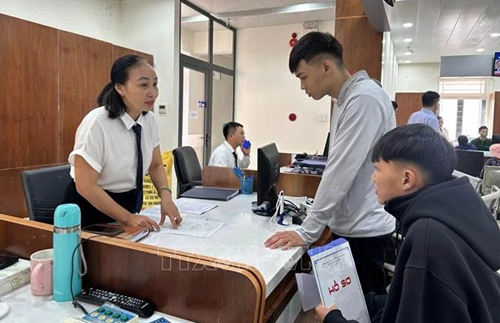Talking with Vietnam News Agency (VNA) reporters in Geneva on July 1 when Vietnam held a nationwide ceremony unveiling the reforms, Isenschmid described the changes as a pivotal step toward creating a more sustainable and globally integrated development model. This is not just about redrawing boundaries, but a deliberate effort to reorganize Vietnam’s economic landscape, fostering stronger, more cohesive regions that can compete on the global stage.
    |
 |
|
At a public service center in Tam Ky ward, Da Nang city |
The reforms, which include consolidating administrative units and establishing new Party organizations and leadership structures, aim to streamline governance and curb resource fragmentation, she noted.
Isenschmid stressed that larger administrative-economic zones could make Vietnam a magnet for international investors, who value long-term stability and regional coordination. When localities achieve greater scale and integration, it paves the way for more effective public-private partnerships that align with global standards.
The SVEF, which has facilitated high-level dialogues between Swiss and Vietnamese officials in recent years, sees the reforms as a catalyst for multi-sector ecosystems where finance, technology, tourism, and innovation converge, she said, spotlighting opportunities for cross-border cooperation between Vietnamese provinces and Swiss partners, particularly in green finance, hi-tech manufacturing, vocational training, and creative entrepreneurship.
In recent years, the SVEF has actively held various events attended by high-ranking Vietnamese delegations, aiming to translate the Switzerland - Vietnam comprehensive partnership into tangible projects.
Looking ahead, the SVEF plans to host a major event in Da Nang this November. Commenting on the merger of Da Nang and Quang Nam, Isenschmid called it a strategic turning point, not just administratively, but also in terms of regional economic development.
With Vietnam seeking to foster regional financial centers, this merger can create a development space of sufficient scale, combining geographic advantage, robust infrastructure, human capital, and a shared development vision, she explained. Geographically, Da Nang and Quang Nam sit at the heart of the East-West Economic Corridor, providing seamless connectivity to potential markets across ASEAN and the broader Asia-Pacific – a prerequisite factor for building a finance hub with international reach.
Da Nang’s existing infrastructure, including deep-water ports, an international airport, and large industrial and hi-tech zones, positions it well to foster a financial-investment and fintech ecosystem. Notably, Da Nang has long been recognized for its pioneering administrative reforms and transparent investment procedures.
Policy stability and consistency are major draws for financial investors, particularly amid ongoing global value chain restructuring, she noted.
She concluded that if Da Nang continues to strengthen its legal framework to support innovation, pilot sandbox models for digital finance, and court international financial institutions, a regional financial hub is within reach.
Underscoring the importance of human capital and international cooperation, she said the growing presence of universities, research institutes, and development organizations in Da Nang would cultivate a workforce skilled in finance, banking, and insurance, and foster collaboration among the State, businesses, and academia.
With all these factors in place, she hoped to see Da Nang - Quang Nam become a new financial center, a goal grounded in practical potential.
Source: VNA